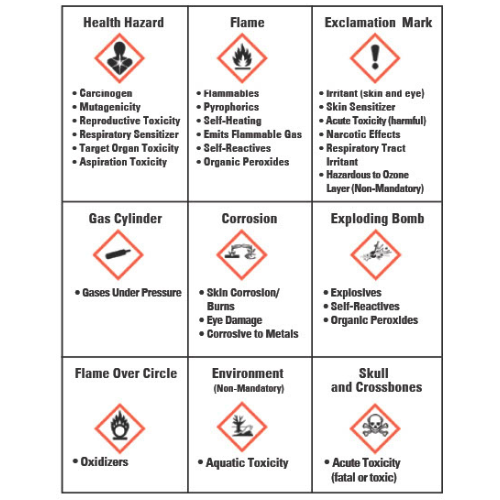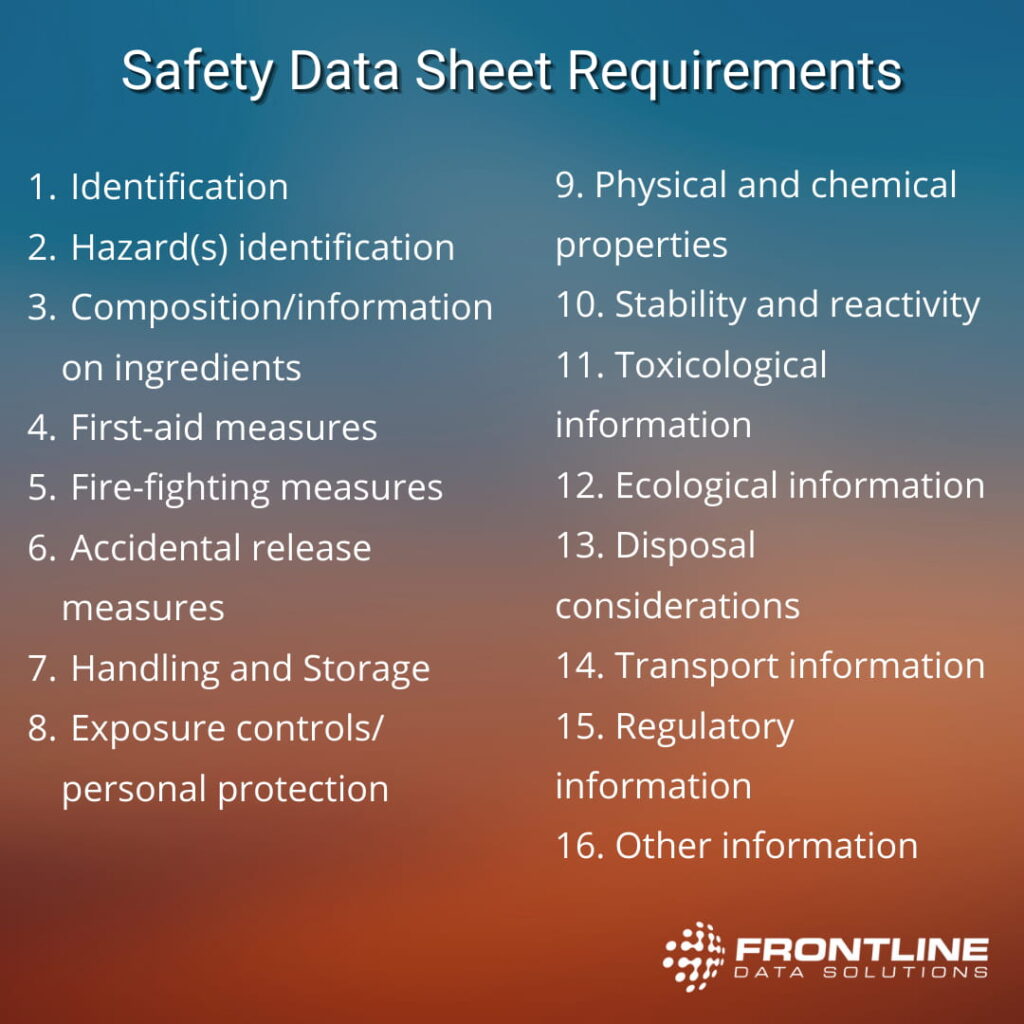Safety data sheets list out any requirements regarding the handling, transport, and storage of hazardous chemicals. To comply with safety data sheets requirements, these documents, previously known as MSDS, must now be kept and distributed in a user-friendly, listicle format. Safety data sheets should include information like the chemical manufacturer, distributor, or importer of the chemical.
Ensuring employees are trained to read and understand safety data sheets can keep your workforce safe and avoid non-compliance. Employers are also required to provide easy access to SDSs for their employees. Within the 16-section Safety Data Sheets standard, there is mandatory and non-mandatory information to include. Here’s a wrap up of each SDS requirement under the Hazard Communication Standard.
Free template!
Use this comprehensive template to create safety data sheets for your own products and/or materials.
Mandatory safety data sheet requirements
The requirements for safety data sheets include quite a few mandatory sections. Below, I list each required section and what it entails.
Identification
The identification section contains all the basic information regarding the chemical. This includes the product identifier, contact information of the manufacturer, or importer, uses and recommendations when using the product and any restrictions there may be regarding the chemical.
Hazard identification
This section is different from identification because it focuses on the hazards involved when using or handling the product. The required information includes hazard classifications and statements, pictograms or signal words, a description of any hazards not classified, or mixtures that contain unknown toxicity.
There are 9 different pictograms that could be used on safety data sheets. Here’s a list of the different hazard symbols:
- Exploding bomb
- Corrosion
- Flame over circle
- Gas cylinder
- Environment
- Skull & Crossbones
- Exclamation
- Health Hazard
- Flame

Composition and information on ingredients on safety data sheets
The composition and the different ingredients used within the chemical are critical pieces of information for safely handling chemicals. This means the SDS should include the name of the chemicals or their synonyms, the CAS (Chemical Abstracts Service) number and identifiers, and finally the exact percentage, concentration, and cut-off of chemicals.
First-aid measures
Knowing the symptoms along with the necessary health measures that employees need to take in case of exposure to the chemicals can help save lives. That is why this section must include the potential symptoms or effects that people may experience when exposed. It should also contain first aid measures for different types of exposures.
Fire-fighting measures
For any potential fire hazards, employees must refer to the fire-fighting measures section of the SDS. This section will include recommendations on what to do during a fire like the required equipment and materials to properly extinguish the fire or protective equipment that must be used when handling the chemical.
Accidental release measures
Accidental release measures refer to the emergency actions in case of spills, releases, or leaks. It provides a list of emergency procedures needed to follow like evacuations, expert assistance or using the necessary protective clothing. This section also includes personal precautions that need to be taken along with cleanup and containment information to minimize the exposure of the chemical.
Handling and storage
Each chemical might have its own storage and handling requirements. Therefore, it’s critical to include this information within the SDS. These requirements can include things like not overcrowding shelves, storing containers at eye level, general hygiene practices and not storing incompatible chemicals in the same area.
Exposure controls/Personal protection
Exposure controls signify the limits of exposure and the personal protection that workers need to use when in contact with the chemical. There may be different exposure limits on the SDS such as OSHA’s Permissible Exposure Limit, the Threshold Limit Value (TLV) from ACGIH, or the recommended limits from the manufacturer, importer, or employer.
Physical and chemical properties
There are more than a dozen different features that go into the physical and chemical properties of the material. You must include all of these in the SDS. Some of these features are physical state, color, odor, boiling and freezing point, flammability, density, how it behaves when mixed with other chemicals and much more.
Stability and reactivity
The stability and reactivity section includes 3 parts; reactivity, chemical stability, and “other.” The types of information found under these sections will refer to the possibility of hazardous reactions, the conditions it can withstand, and any specific tests or observations that have been conducted. It’s important to remember that the more stable a chemical is, the less reactive it will be.
Toxicological information
Toxicological information will include information on the health effects of the chemical. From the routes of exposure and ATE (Acute Toxicity Estimate) to related symptoms and the lethal dose, this section provides the necessary values and data on what the health effects or the chemical could be.

Non-mandatory requirements for safety data sheets
The non-mandatory sections of SDS contain information about the environmental impact of the chemical, and how it should be disposed of and transported, along with other regulatory information like when the SDS sheet was last updated. The ecological information section will talk about persistence and degradability, mobility in soil, and ecotoxicity. The disposal considerations of the chemical might include information on the handling and recyclability of the packaging of the material.
Although it isn’t mandatory, the UN number and the transport hazard class of the material can be found in the transport information section of the SDS. And lastly, regulatory, and other information such as what the regulations for certain chemicals are or when the SDS was prepared and updated could be found in sections 15 and 16.
To boil it down, requirements for safety data sheets are there to clearly describe the identification of the product, the hazards involved, the protection needed for safely handling the product and the response needed when dealing with exposures.




